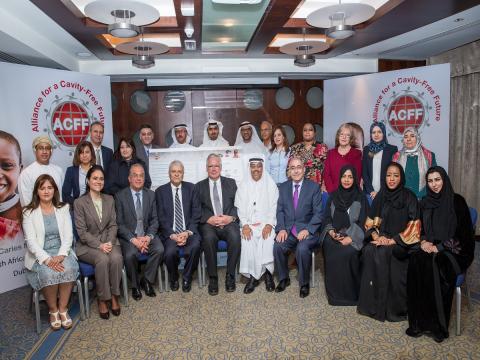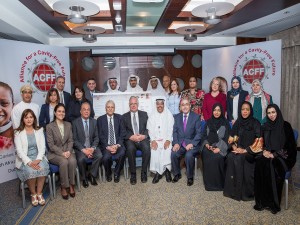Published 10 years ago
Last updated 10 years ago

- On average people in the North Africa and Middle East have 1.9 decayed, missing or filled teeth each, rising to 4.6 in some countries
- More than 90% of 6-12 year-olds in some Arab countries suffer from untreated tooth decay
- Tooth decay is one of most common but treatable chronic diseases in the world
Dubai, UAE17thFebruary, 2015: Joining together today in the UAE, North Africa and Middle East (NAME) leaders in dentistry and public health launched a regional campaign to stop cavities, the Alliance for a Cavity-Free Future (the Alliance). TheNAMEAlliance calls for national collaborative action to challenge leaders and stakeholders in the community to learn the importance of tooth decay by recognising that cavities are preventable and in the early stages reversible, and to develop comprehensive programmes for prevention and management across the region.
 Tooth decay is the most common chronic disease on the planet, affecting five billion people, or nearly 80 percent of the world’s population.1On average, people in the NAME region have 1.9 instances of DMFT – Decayed, Missing, or Filled Teeth – each, with some countries’ populations averaging up to 4.6 DMFT per person. In several countries, the number of six year olds with untreated caries is higher than 80 percent and as much as 100 percent.
"Tooth decay is the most common chronic disease in the world,” said Prof. Jawad Behbehani, Dean of the Faculty of Dentistry of Kuwait University, and Chairman of the NAME Alliance. “In some of our Arab countries more than 90 percent of 6-12year-olds have untreated tooth decay. The level of resources and intervention from both a public health and clinical perspective is inconsistent in our region, which means that in some Arab countries, the vast majority of children are suffering from a problem that we know how to stop. Tooth decay deserves greater attention in order to elevate it as an important health issue,” he added.
Regional Declaration to Elevate New Way of Looking at Caries
As part of the events at the launch, national leaders signed a national declaration committing to the goals of the Alliance. Individuals signing the declaration included members of the Alliance’s Expert Panel and representatives for various sectors of the dental and public health profession, including Prof. Nigel Pitts, Chairman of the Alliance for a Cavity Free Future; Prof. Jawad Behbehani, Chairman of the NAME Chapter of the Alliance for a Cavity Free Future; Prof. Mounir Doumit, Coordinator for Levant Countries, NAME Chapter of the Alliance for a Cavity Free Future; Prof. Abdullah Al Shammery, Coordinator for GCC countries, NAME Chapter of the Alliance for a Cavity Free Future; and Prof. Ihssane Benyahya, Coordinator for North Africa countries and NAME Chapter for the Alliance for a Cavity Free Future.
Ongoing Public Health Action
Regionally, the NAME Alliance will work to implement what the global Alliance has identified as long-term goals:
Tooth decay is the most common chronic disease on the planet, affecting five billion people, or nearly 80 percent of the world’s population.1On average, people in the NAME region have 1.9 instances of DMFT – Decayed, Missing, or Filled Teeth – each, with some countries’ populations averaging up to 4.6 DMFT per person. In several countries, the number of six year olds with untreated caries is higher than 80 percent and as much as 100 percent.
"Tooth decay is the most common chronic disease in the world,” said Prof. Jawad Behbehani, Dean of the Faculty of Dentistry of Kuwait University, and Chairman of the NAME Alliance. “In some of our Arab countries more than 90 percent of 6-12year-olds have untreated tooth decay. The level of resources and intervention from both a public health and clinical perspective is inconsistent in our region, which means that in some Arab countries, the vast majority of children are suffering from a problem that we know how to stop. Tooth decay deserves greater attention in order to elevate it as an important health issue,” he added.
Regional Declaration to Elevate New Way of Looking at Caries
As part of the events at the launch, national leaders signed a national declaration committing to the goals of the Alliance. Individuals signing the declaration included members of the Alliance’s Expert Panel and representatives for various sectors of the dental and public health profession, including Prof. Nigel Pitts, Chairman of the Alliance for a Cavity Free Future; Prof. Jawad Behbehani, Chairman of the NAME Chapter of the Alliance for a Cavity Free Future; Prof. Mounir Doumit, Coordinator for Levant Countries, NAME Chapter of the Alliance for a Cavity Free Future; Prof. Abdullah Al Shammery, Coordinator for GCC countries, NAME Chapter of the Alliance for a Cavity Free Future; and Prof. Ihssane Benyahya, Coordinator for North Africa countries and NAME Chapter for the Alliance for a Cavity Free Future.
Ongoing Public Health Action
Regionally, the NAME Alliance will work to implement what the global Alliance has identified as long-term goals:
- By 2015, 90 percent of dental schools and dental associations should have embraced and promoted the “new” approach of “caries as a continuum” to improve dental caries prevention and management.
- By 2020, regional members of the Alliance for a Cavity-Free Future should have integrated, locally appropriate, comprehensive caries prevention and management systems and monitoring developed and in place.
- Every child born in 2026 should stay cavity free during their life time.
Categories
- Log in to post comments